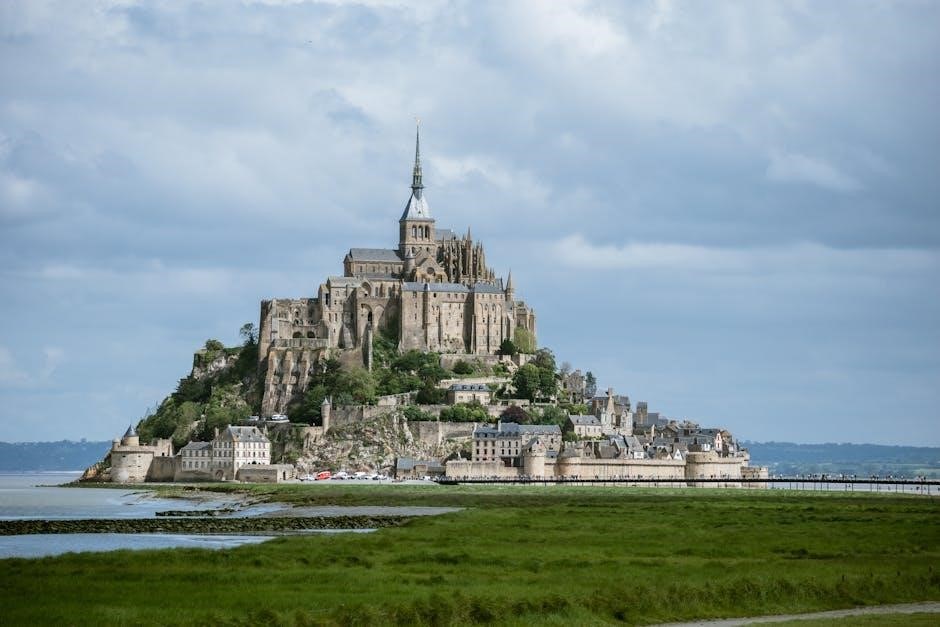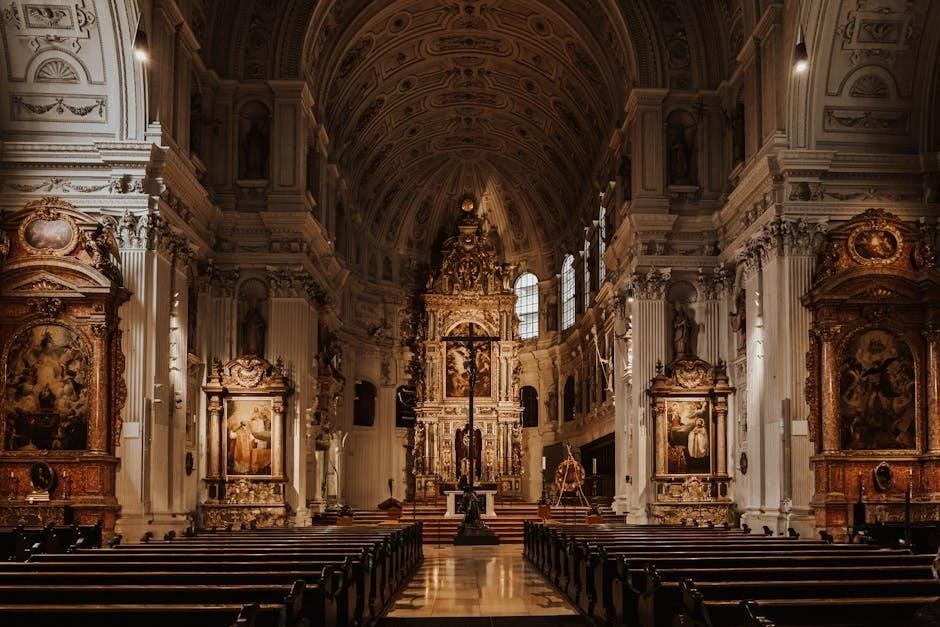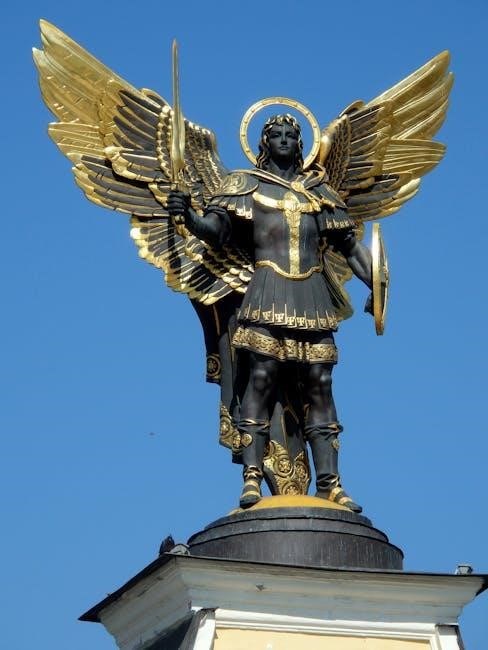Guido Reni’s 17th-century masterpiece, St. Michael the Archangel, epitomizes Baroque art with its dynamic composition and emotional depth, capturing the eternal struggle between good and evil.
Who Was Guido Reni?
Guido Reni was a prominent Italian painter of the Baroque era, born in 1575 in Bologna and active until his death in 1642. Renowned for his classical style, he was a leading figure in the Bolognese School of painting, which emphasized harmony and elegance. His works often depicted religious and mythological themes, blending emotional depth with refined technique. Reni’s artistic career flourished in 17th-century Italy, where he gained acclaim for his ability to balance dramatic expression with serene compositions. His painting of St. Michael the Archangel remains one of his most celebrated works, showcasing his mastery of light and form.
The Significance of St. Michael the Archangel in Art
St. Michael the Archangel has long been a symbol of divine victory and justice in art, often depicted as a warrior defeating Satan. His imagery represents the triumph of good over evil, resonating deeply with religious and cultural themes. In Guido Reni’s work, the archangel embodies this duality, capturing the cosmic struggle between light and darkness. The depiction of St. Michael in art serves as a powerful visual narrative, inspiring awe and reflection. Reni’s portrayal, with its dramatic poses and emotional intensity, highlights the archangel’s enduring role as a protector and defender in Christian iconography.
Historical Background of the Painting
Guido Reni’s St. Michael the Archangel was painted in the early 17th century, commissioned by Cardinal Antonio Barberini for the church of Sant’Onofrio in Rome, marking a significant religious and artistic project of its time.
The Commission and Patronage
The painting was commissioned by Cardinal Antonio Barberini, a prominent figure in 17th-century Rome, for the church of Sant’Onofrio. This commission underscored Reni’s reputation as a leading artist of his time, reflecting the cardinal’s desire to adorn the chapel with a powerful religious image. The patronage highlighted the interplay between religious devotion and artistic excellence, as Barberini sought to create a visually stunning and spiritually impactful work. This collaboration not only elevated Reni’s status but also contributed to the rich artistic heritage of the era.
Historical Context of the 17th Century
The 17th century was a time of religious and cultural transformation in Europe, marked by the Catholic Church’s efforts to counter the Protestant Reformation. Art played a central role in this movement, with works like Guido Reni’s St. Michael the Archangel serving as powerful visual narratives to inspire devotion. The painting, created in 1636, reflects the Baroque era’s emphasis on dramatic expression and emotional intensity. It was also a period of political turmoil, with conflicts like the Thirty Years’ War, which may have influenced the depiction of St. Michael as a symbol of triumph over adversity.
Artistic Style and Technique
Guido Reni’s St. Michael the Archangel showcases his classical style, blending harmonious lines and balanced forms with dramatic chiaroscuro, creating a captivating interplay of light and shadow.
Guido Reni’s Classical Style
Guido Reni’s classical style in St. Michael the Archangel reflects his adherence to harmonious proportions, balanced forms, and idealized beauty, influenced by ancient Greek and Roman art. His meticulous attention to detail and refined technique emphasize symmetry and grace, while his use of light and shadow creates a sense of depth and emotional resonance. The painting embodies the classical ideal of beauty, blending technical precision with spiritual intensity, making it a quintessential example of 17th-century classical art.
The Use of Chiaroscuro in the Painting
Guido Reni masterfully employed chiaroscuro in St. Michael the Archangel, using dramatic contrasts of light and shadow to heighten the emotional and spiritual impact of the scene. The radiant light illuminates St. Michael, emphasizing his divine nature, while the darker tones in the background and on Satan’s figure create a sense of depth and moral tension. This technique not only enhances the painting’s visual drama but also underscores the triumph of good over evil, drawing the viewer’s eye to the central figure and reinforcing the narrative’s spiritual significance.
Symbolism and Iconography
Guido Reni’s depiction of St. Michael the Archangel is rich in symbolic elements, with the archangel representing divine justice and triumph over evil, while Satan embodies sin and defeat.

St. Michael as a Symbol of Victory Over Evil

Guido Reni’s painting masterfully portrays St. Michael as a symbol of divine triumph, embodying courage and righteousness. The archangel’s armor and uplifted sword signify strength and justice, while his serene expression reflects unwavering faith. By defeating Satan, St. Michael represents the universal struggle between light and darkness, reinforcing his role as a protector of the faithful. This depiction not only highlights Reni’s artistic skill but also underscores St. Michael’s enduring cultural and religious significance as a victorious figure in the battle against evil.
The Depiction of Satan and His Defeat
Guido Reni’s depiction of Satan in his painting of St. Michael the Archangel portrays the fallen angel in a state of defeat and subjugation, with distorted features that embody evil. Satan is shown being trampled by the archangel, emphasizing his powerlessness against divine authority. The painting captures the dramatic struggle between good and evil, with St. Michael’s sword raised triumphantly. Reni’s use of chiaroscuro highlights the contrast between the celestial light of St. Michael and the darkness associated with Satan, underscoring the theme of spiritual victory. This portrayal powerfully reinforces St. Michael’s role as a protector and defender of faith.

The Painting’s Composition
Guido Reni’s painting features St. Michael as the central figure, poised in a powerful stance, with dynamic lines and light creating a sense of divine authority and balance.
The Central Figure of St. Michael
Guido Reni’s depiction of St. Michael emphasizes his divine authority and strength. The archangel stands triumphantly, wearing a Roman military cloak and cuirass, symbolizing his role as a warrior of light. His posture exudes confidence, with one foot firmly planted on Satan’s head, signifying victory over evil. The artist’s use of chiaroscuro highlights Michael’s face and armor, creating a radiant contrast against the dark background. This central figure commands attention, embodying the theme of divine triumph and moral righteousness, making it a focal point of the composition. The painting’s emotional depth is enhanced through Reni’s masterful portrayal of St. Michael’s serene yet powerful expression.
The Dynamic Layout and Movement
Guido Reni’s painting captivates with a dynamic layout that conveys intense energy and movement. The composition is structured diagonally, with St. Michael descending from heaven, his sword raised high, creating a sense of fluid motion. Satan, depicted in a twisting pose, adds to the dramatic tension. Reni’s masterful use of chiaroscuro enhances the emotional impact, with light and shadow accentuating the archangel’s graceful yet powerful form. The interplay of lines and movement draws the viewer’s eye upward, emphasizing the celestial nature of St. Michael and the chaotic struggle below. This dynamic arrangement heightens the painting’s emotional and visual appeal, engaging the viewer deeply.

Reception and Legacy
Guido Reni’s St. Michael the Archangel became an enduring masterpiece, celebrated for its emotional depth and classical style. It influenced Baroque art and remains a timeless inspiration.
Impact on Baroque Art
Guido Reni’s St. Michael the Archangel significantly influenced Baroque art, setting a standard for dynamic compositions and emotional intensity. His masterful use of chiaroscuro and classical ideals inspired many artists, blending dramatic movement with harmonious elegance. The painting’s vivid depiction of light and shadow, along with its spiritual themes, became a hallmark of Baroque artistry. Reni’s work not only reflected the era’s artistic trends but also shaped them, leaving a lasting legacy in the development of Baroque painting.
Modern Interpretations and Appreciation
Guido Reni’s St. Michael the Archangel continues to captivate modern audiences with its timeless themes of light vs. darkness and divine triumph. Contemporary art enthusiasts and scholars admire the painting’s emotional intensity and masterful execution. The dynamic composition and vivid use of chiaroscuro resonate deeply, evoking reflections on universal struggles. Its enduring appeal lies in its ability to transcend centuries, inviting viewers to connect with its spiritual and aesthetic brilliance. Today, the artwork remains a celebrated example of Baroque artistry, inspiring both admiration and introspection in a modern context.

Secrets and Scandals
Guido Reni’s St. Michael the Archangel hides stories of scandal, including rumors of artistic disputes and a controversial patronage involving a powerful cardinal.
Hidden Stories Behind the Painting
Guido Reni’s St. Michael the Archangel conceals intriguing narratives, including rumors of artistic disputes during its creation. The painting, commissioned by Cardinal Antonio Barberini, was reportedly embroiled in controversy, with some speculating about the cardinal’s motives and Reni’s reluctance to accept the project. Additionally, the work is said to have been completed amidst personal turmoil in Reni’s life, adding layers of emotional depth to its execution. These stories, while not fully documented, enrich the painting’s legacy, hinting at the complexities behind its creation and the artist’s inner struggles.
Guido Reni’s St. Michael the Archangel remains a timeless masterpiece, blending artistic excellence with profound symbolism, ensuring its enduring appeal and historical significance in the art world.

Guido Reni’s Enduring Legacy
Guido Reni’s artistry left an indelible mark on Baroque painting, blending classical elegance with emotional intensity. His St. Michael the Archangel showcases his mastery of chiaroscuro and dynamic composition. Reni’s ability to capture dramatic tension and divine grace influenced countless artists. The painting’s intricate details and symbolic depth continue to inspire modern interpretations. Commissioned by Cardinal Antonio Barberini, it reflects the religious and cultural values of its time. Reni’s legacy endures through his timeless depictions of spiritual and human struggles, ensuring his work remains a cornerstone of art history.
The Timeless Appeal of St. Michael the Archangel
St. Michael the Archangel’s enduring appeal lies in its emotional and symbolic power, transcending time and culture. The painting embodies the universal theme of good triumphing over evil, resonating deeply with viewers. Its dramatic beauty and spiritual depth inspire reflection on eternal struggles. Reni’s masterpiece continues to captivate modern audiences, bridging the past and present. The archangel’s victorious yet compassionate portrayal evokes hope and strength, making it a timeless icon of faith and artistry.